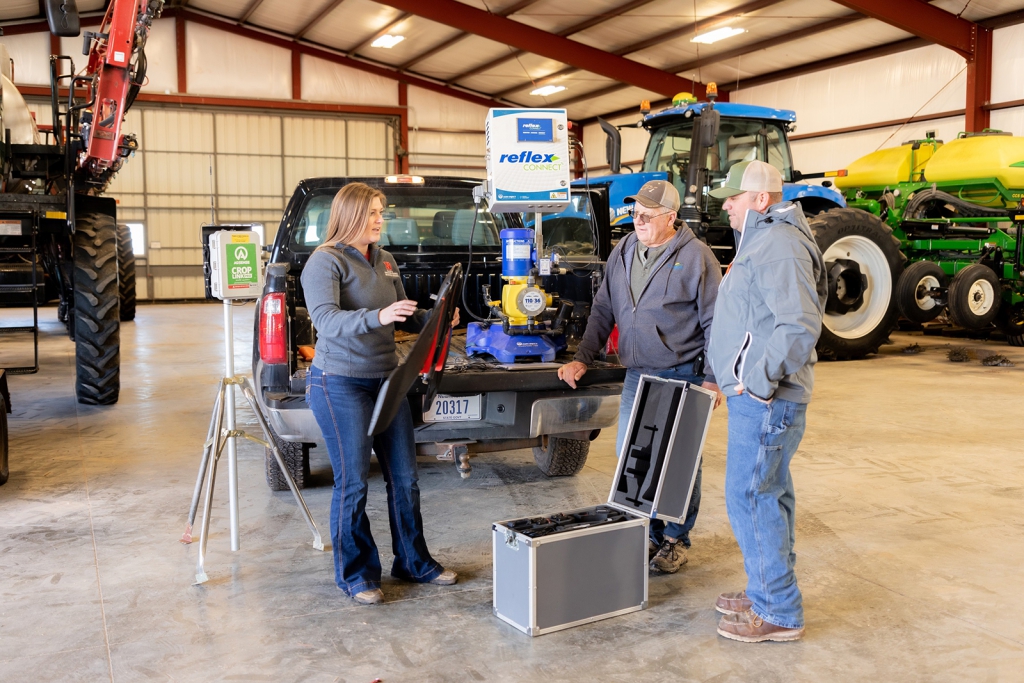Biological Systems Engineering
Geitner Simmons, March 9, 2023
Sensor-based fertigation management research boosts efficiency, profitability
For the past four years, University of Nebraska–Lincoln researchers have studied the prospects for using sensor-based fertigation management, or SBFM, to increase the efficiency and profitability of nitrogen use. The latest results are now in from multiple Nebraska sites, and they show that the technology enables major gains in both regards.
“This method allows the sensors and imagery to detect what that crop needs, so that you’re not overapplying nitrogen,” said Taylor Cross, a graduate research assistant who oversaw the project last year. “You’ll really see a lot of nitrogen savings with this method.”
For the project, drones provided weekly updates on crop-condition data by using multispectral imagery that showed nitrogen levels. Analysis of the data via N-Time software then directed specific applications of liquid fertilizer by irrigation equipment in a set of eastern Nebraska cornfields.
At all three on-farm test sites in 2022, the approach produced greater efficiency in nitrogen use than did conventional management, with efficiency measured in pounds of nitrogen per bushel of grain. The two SBFM-recommended approaches produced about 44 pounds more grain per pound of nitrogen than did the growers’ traditional method. The two SBFM-recommended methods also showed the potential for boosting profitability. The increases ranged from $28 per acre to just over $40 per acre, on average, across the three sites.
Sensor-based fertigation management “allows the farmer to really take advantage of all these sources of nitrogen, not just having to rely on nitrogen products such as (urea and ammonium nitrate) or anhydrous,” said Cross, who is pursuing a master’s degree in mechanized systems management under the mentorship of Joe Luck, associate professor of biological systems engineering. “We’re putting nitrogen in season more effectively, and in a timelier manner, to allow for optimum efficiency.”
The project contributes to Nebraska Extension’s longstanding On-Farm Research Network. The 2022 results from all the network’s projects are now available in a comprehensive online roundup.
As part of the project, treatments were applied via pivot irrigation of wedge-shaped sectors on quarter sections. Sectors using various SBFM treatments were adjacent to or near sectors using conventional nitrogen management.
One of the advantages of SBFM is its ease of use, said Cross, a cohost of the university’s FarmBits podcast.

“If you’re a farmer who’s already fertigating, and the site has been set up in N-Time, the technology is very simple in that your pivot is really doing all the work for you,” she said. “This technology’s automation is really easy to use and has a lot of functionality with all the data it provides.”
The multi-year approach helped researchers make adjustments over time. Some of the refinements resulted in greater efficiency and profitability.
As participating producers became more familiar with the project, researchers began the SBFM approach earlier in the growing season, at the V6 stage. That earlier start, Cross explained, “allowed for more control over the growing season, to really allow this method and imagery to perform at its best.”
Another adjustment was the development of a method called the Increased Rate Treatment, which boosted the nitrogen-uptake curve.
“From the V9 to V14 growth stages,” Cross said, “we increased the rate of application to 60 pounds of nitrogen per acre compared with the conventional 30 pounds per acre.”
Since 2020, the standard 30-pounds-of-nitrogen approach has returned an increase on profitability of $19 across 10 on-farm field study sites; the Increased Rate Approach has increased profitability by $40 per acre at three sites. These approaches have improved nitrogen-use efficiency by producing 26 more pounds of grain per pound of nitrogen, on average, compared with the growers’ management practices.
“We’ve tested other variations,” Cross said. “We extended into the R4 growth stage, where typically we’d stop at R3. So there’s been some fine-tuning here and there to adjust these efficiency and profitability metrics.”
The sensor-based approach is used by Sentinel Fertigation, whose founder and CEO, Jackson Stansell, wrote the N-Time software. When the on-farm research began in 2019, Stansell, then a Husker graduate research assistant, headed the field studies.
The SBFM technology “has a lot of potential” for future adoption in Nebraska agriculture, Cross said. Given the major increases in nitrogen-use efficiency the technology enables, “that’s really promising for Nebraska farmers to minimize overapplication and any nitrogen that could be leached to groundwater.”
A central, unique aspect of sensor-based fertigation management, Cross said, is that “we don’t have to make our ultimate nitrogen plan at the beginning of the year. In fact, we don’t need a total nitrogen goal or a yield goal for this technology to be successful.” Instead, producers are “just solely watching that crop and what it needs that week.”
Biological Systems Engineering Institute of Agriculture and Natural Resources





